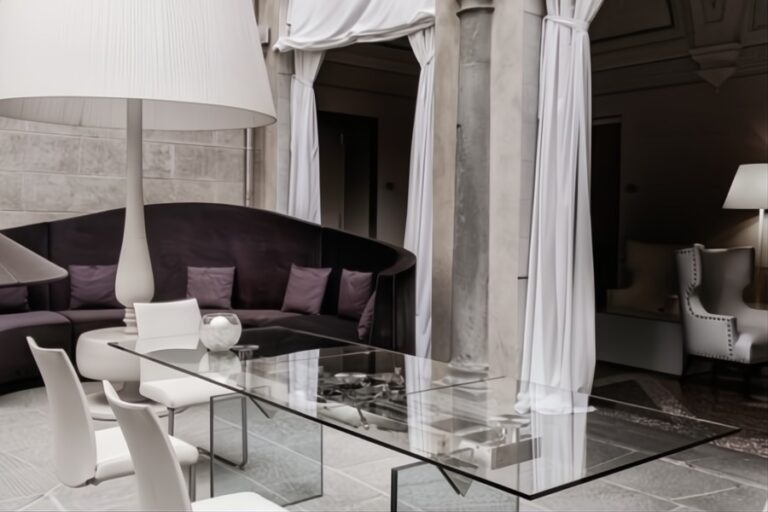The kitchen is often thought of as the heart of the home – a space where family and friends gather to cook, eat and socialize.
Therefore, your kitchen layout and furniture arrangement play a vital role in your kitchen's functionality, efficiency, and overall aesthetics. Whether you're renovating an existing kitchen or designing a new one from scratch, it's essential to understand the different layout options and how to choose the right furniture arrangement for your space. In this article, we explore the basic principles of kitchen layout design and provide practical tips for choosing the perfect furniture arrangement to suit your needs and style.
Understanding the work triangle
At the core of any functional kitchen layout is the concept of the work triangle. This principle states that a kitchen's three main work areas (sink, refrigerator, and stove) should form a triangle with each side measuring 4 to 9 feet. The sum of the three sides should be 13 to 26 feet. This arrangement allows cooks to move efficiently between these main areas without obstacles or unnecessary steps.
When planning your kitchen layout and furniture arrangement, consider the following guidelines related to the working triangle:
- Keep the work triangle compact: Make sure the distance between your sink, refrigerator, and stove isn't too wide, which can lead to inefficiency and fatigue during meal preparation.
- Minimize foot traffic through the work triangle: Arrange furniture and other kitchen elements to minimize foot traffic through the work triangle. Otherwise, it can impede cooking workflow and create congestion.
- Keep the work triangle free of obstacles: Keep the work triangle free of obstacles, such as islands or tall cabinets, that could restrict movement or block access to primary work areas.
By following the principles of the work triangle, you can create a kitchen layout that promotes efficiency, functionality, and ease of use.
Typical kitchen layout
There are several common kitchen layouts, each with its own characteristics and benefits, and understanding these layouts can help you decide which one best suits your space, lifestyle, and design preferences.
- U-Shaped Layout: This layout has three walls of cabinets and appliances arranged in a U-shape. It provides plenty of counter space and storage, but it may feel claustrophobic from the perspective of adjacent rooms.
- L-Shaped Layout: An L-shaped kitchen has two vertical walls of cabinetry and appliances, creating an open, efficient work area. This layout works well for small to medium-sized spaces and allows for easy communication with adjacent rooms.
- Galley Layout: Also known as a hallway kitchen, this layout places cabinets and appliances along two parallel walls with a narrow passageway between them. This is an efficient use of space, but can feel cramped if the passageway is too narrow.
- Island Layout: This layout incorporates a freestanding island in the center of the kitchen that can be used for additional prep space, storage or seating. Islands are a good choice for larger kitchens and help create a more open, sociable feel.
- Peninsula Layout: Similar to the island layout, a peninsula is attached to one wall and extends outward, creating a barrier between the kitchen and an adjacent room. This layout can provide additional counter space and seating without the need for a separate island.
When choosing the layout that best suits your needs, consider the size, shape and intended use of your kitchen.
Become a Harlem insider!
By submitting this form, you consent to receiving marketing emails from Harlem World Magazine, 2521 1/2 west 42nd street, Los Angeles, CA, 90008, https://www.harlemworldmagazine.com. You can revoke your consent to receive emails at any time by using the SafeUnsubscribe® link at the bottom of the email. Emails are delivered by Constant Contact.
Optimizing the placement of cabinets and appliances
The placement of your cabinets and appliances plays a vital role in the functionality and efficiency of your kitchen. When arranging these elements, consider the following tips:
- Group similar items: Items that you use together, like pots and pans, dishes and glassware, should be stored near each other for easy access.
- Keep frequently used items within reach: Place the items you use most often, like your daily dishes and cookware, in cabinets and drawers that are easily accessible.
- Maximize vertical space: Install tall cabinets or open shelving to utilize the full height of your kitchen walls, providing additional storage and display space.
- Consider the size and placement of your appliances: Make sure your appliances will fit comfortably within your chosen layout and that there is enough space around them to use them safely and efficiently.
- Get the right lighting: Install adequate task lighting above work surfaces such as countertops and stoves to ensure good visibility and safety while preparing food.
Careful placement of cabinets and appliances can help you create a kitchen that is both functional and visually appealing.
Setting up seating and dining areas
In addition to serving as the main work area, the kitchen often doubles as a gathering space for eating and socializing. When incorporating seating and dining areas into your kitchen layout, consider the following options:
- Kitchen island seating: If your kitchen has an island, consider adding bar-style seating on one side to create a casual dining space or a place where guests can socialize while the cook prepares meals.
- Built-in banquettes: Built-in banquettes provide a cozy, space-efficient seating area in a corner of the kitchen, perfect for casual meals or intimate gatherings.
- Adjacent dining room: If your kitchen opens onto a dining room, choose a furniture arrangement that allows you to move easily between the two spaces. A contemporary dining table that matches the style of your kitchen will help create a unified, inviting atmosphere.
- Breakfast Nook: A small dedicated dining area within the kitchen, often set in a corner or near a window, can be an inviting and convenient place to enjoy a casual meal or your morning coffee.
When choosing your seating and dining furniture, consider the size of your kitchen, the number of people it will typically need to accommodate, and the overall style of your home to ensure a harmonious and functional arrangement.
Balancing style and functionality
Although functionality is the main focus of your kitchen layout, it's also important to consider the aesthetics of the space. Aim to strike a balance between practicality and style when choosing your furniture and decor items.
To create a visually appealing and functional kitchen, consider the following tips:
- Choose a cohesive color palette: Choose a color scheme that matches the overall style of your home and creates a welcoming atmosphere in your kitchen.
- Mix and match materials: Combine different materials such as wood, metal, glass and stone to add visual interest and depth to your kitchen design.
- Choose durable, easy-to-clean surfaces: Select countertops, flooring and furniture finishes that can withstand the wear and tear of everyday kitchen use and are easy to maintain.
- Add a personal touch: Add personality to your kitchen with artwork, family photos and treasured possessions to make the space your own.
By carefully balancing style and functionality, you can create a kitchen that is not only highly functional, but also serves as a beautiful, inviting space to gather with family and friends.
Conclusion
Choosing the right furniture arrangement for your kitchen is essential to creating a space that is both functional and aesthetically pleasing. By understanding the principles of the work triangle, considering common kitchen layouts, optimizing cabinet and appliance placement, incorporating seating and dining areas, and balancing style and functionality, you can design a kitchen that meets your unique needs and reflects your personal tastes.
Remember, the secret to a successful kitchen layout is careful planning and attention to detail. Take the time to assess your space, consider your lifestyle and cooking habits, and choose furniture and decor elements that prioritize both practicality and aesthetics. With thoughtful consideration and a clear vision, you can create a kitchen that is the true heart of your home — a space where memories are made and cherished for years to come.




